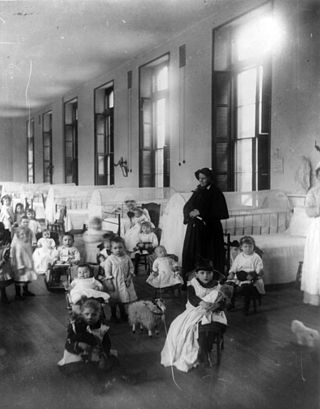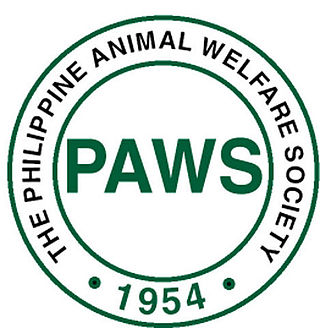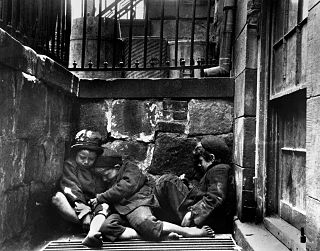Related Research Articles

Adoption is a process whereby a person assumes the parenting of another, usually a child, from that person's biological or legal parent or parents. Legal adoptions permanently transfer all rights and responsibilities, along with filiation, from the biological parents to the adoptive parents.
Child abandonment is the practice of relinquishing interests and claims over one's offspring in an illegal way, with the intent of never resuming or reasserting guardianship. The phrase is typically used to describe the physical abandonment of a child, but it can also include severe cases of neglect and emotional abandonment, such as when parents fail to provide financial and emotional support for children over an extended period of time. An abandoned child is referred to as a foundling. Baby dumping refers to parents leaving a child younger than 12 months in a public or private place with the intent of terminating their care for the child. It is also known as rehoming when adoptive parents use illegal means, such as the internet, to find new homes for their children. In the case where child abandonment is anonymous within the first 12 months, it may be referred to as secret child abandonment.

An orphanage is a residential institution, total institution or group home, devoted to the care of orphans and children who, for various reasons, cannot be cared for by their biological families. The parents may be deceased, absent, or abusive. There may be substance abuse or mental illness in the biological home, or the parent may simply be unwilling to care for the child. The legal responsibility for the support of abandoned children differs from country to country, and within countries. Government-run orphanages have been phased out in most developed countries during the latter half of the 20th century but continue to operate in many other regions internationally. It is now generally accepted that orphanages are detrimental to the emotional wellbeing of children, and government support goes instead towards supporting the family unit.
The international adoption of South Korean children was at first started as a result of a large number of orphaned mixed children from the Korean War after 1953, but later included orphaned Korean children. Religious organizations in the United States, Australia, and many Western European nations slowly developed into the apparatus that sustained international adoption as a socially integrated system. This system, however, is essentially gone as of 2020. The number of children given for adoption is lower than in comparable OECD countries of a similar size, the majority of adoptees are adopted by South Korean families, and the number of international adoptees is at a historical low.
International adoption is a type of adoption in which an individual or couple residing in one country becomes the legal and permanent parent(s) of a child who is a national of another country. In general, prospective adoptive parents must meet the legal adoption requirements of their country of residence and those of the country whose nationality the child holds.
An animal rescue group or animal rescue organization is a group dedicated to pet adoption. These groups take unwanted, abandoned, abused, or stray pets and attempt to find suitable homes for them. Many rescue groups are created by and run by volunteers, who take animals into their homes and care for them — including training, playing, handling medical issues, and solving behaviour problems — until a suitable permanent home can be found.
In the United States, adoption is the process of creating a legal parent-child relationship between a child and a parent who was not automatically recognized as the child's parent at birth.

The Philippines' Department of Social Welfare and Development is the executive department of the Philippine Government responsible for the protection of the social welfare of rights of Filipinos and to promote the social development.
Child protective services (CPS) is the name of an agency in many states of the United States responsible for providing child protection, which includes responding to reports of child abuse or neglect. Some states use other names, often attempting to reflect more family-centered practices, such as department of children and family services (DCFS). CPS is also sometimes known by the name of department of social services, though these terms more often have a broader meaning.
The China Center of Adoption Affairs (CCAA) was established on June 24, 1996 by China's Ministry of Civil Affairs. The CCAA is responsible for the welfare of children in the care of Child Welfare Institutes (orphanages), domestic adoption, and international adoption.

The Philippine Animal Welfare Society (PAWS) is a volunteer-based, non-government organization whose goal is to prevent animal cruelty through education, animal sheltering and advocacy, based in Quezon City, Philippines. It was founded in 1954 by Muriel Jay. PAWS believes that the creation of a more peaceful society starts with the widening of mankind's circle of compassion which includes animals, thereby envisions a nation that respects animals, practices responsible pet ownership and protects wildlife. The volunteer-based organization rehabilitates these animals in the hope of finding them new homes and a second chance at a good life. PAWS does not take in pets of other people, but only victims of cruelty or neglect where the animal offenders are charged with violation of the Animal Welfare Act in court.
Adoption in Australia deals with the adoption process in the various parts of Australia, whereby a person assumes or acquires the permanent, legal status of parenthood in relation to a child under the age of 18 in place of the child's birth or biological parents. Australia classifies adoptions as local adoptions, and intercountry adoptions. Known child adoptions are a form of local adoptions.
Mississippi Band of Choctaw Indians v. Holyfield, 490 U.S. 30 (1989), was a case in which the Supreme Court of the United States held that the Indian Child Welfare Act governed adoptions of Indian children. It ruled that a tribal court had jurisdiction over a state court, regardless of the location of birth of the child, if the child or the natural parents resided on the reservation.
The Sixties Scoop, also known as The Scoop, was a period in which a series of policies were enacted in Canada that enabled child welfare authorities to take, or "scoop up," Indigenous children from their families and communities for placement in foster homes, from which they would be adopted by white families. Despite its name referencing the 1960s, the Sixties Scoop began in the mid-to-late 1950s and persisted into the 1980s.

Foster care is the term used for a system in which a minor who has been made a ward is placed in an institution, group home, relative placement, or private home of a state certified caregiver. The placement of the child is usually arranged through the government or a social-service agency. The institution, group home, or foster parent is paid. The state via the family court and child protection agency stand in loco parentis to the minor, making all legal decisions, while the foster parent is responsible for the day-to-day care of the minor. The foster parent is remunerated by the state for their services.

Adoption in the Philippines is a process of granting social, emotional and legal family and kinship membership to an individual from the Philippines, usually a child. It involves a transfer of parental rights and obligations and provides family membership. The Department of Social Welfare and Development (DSWD) defines adoption as a "socio-legal process of giving a permanent family to a child whose parents have voluntarily or involuntarily given up their parental rights."

The Jose Fabella Memorial School is a public integrated special school located in Welfareville Compound, Mandaluyong in Metro Manila, Philippines. Founded on December 3, 1925 as the Welfareville School, it is one of the oldest educational institutions in Mandaluyong and is currently one of the four public special schools in the Philippines. It serves as the umbrella organization of 12 special education units located in different parts of Metro Manila and Rizal and offers kindergarten, elementary, secondary, alternative learning system, and special education to regular learners and learners with special education needs.
AY Foundation (AY) is a charity foundation based in Philippines, that was established with the aim of Welfare for the Society. The foundation is focused in Child Development, Woman Empowerment, Old-Age Home & Also Provides Relief during Pandemic all across the Philippines.
Birth mothers in South Korea (international adoption) refers to the group of biological mothers whose children were placed for adoption in South Korea's international adoption practice. The decades-long phenomenon of international adoption in South Korea began after the Korean War. In the years since the war, South Korea has become the largest and longest provider of children placed for international adoption, with 165,944 recorded Korean adoptees living in 14 countries, primarily in North America and Western Europe, as of 2014.
Spence-Chapin Services to Families and Children is a New York-based licensed and Hague-accredited non-profit providing adoption services, which includes the continuum of counseling and support services to members of the adoption triad: birth parents, adoptive families, and adoptees. They provide interim care for infants as the biological parents make a plan for the child’s future, and also specialize in the adoption of older children, sibling groups and children with special needs.
References
- ↑ Children's Shelter of Cebu in the Philippines
- ↑ "Children's Shelter of Cebu in the Philippines". Archived from the original on 2008-05-15. Retrieved 2008-02-13.
- 1 2 3 4 "Children's Shelter of Cebu in the Philippines". Archived from the original on 2008-02-02. Retrieved 2008-02-13.
- ↑ Sun.Star Cebu - Sun.star's Citizens of 2005 Archived September 27, 2009, at the Wayback Machine
- ↑ Causes | Children's Shelter of Cebu | Facebook